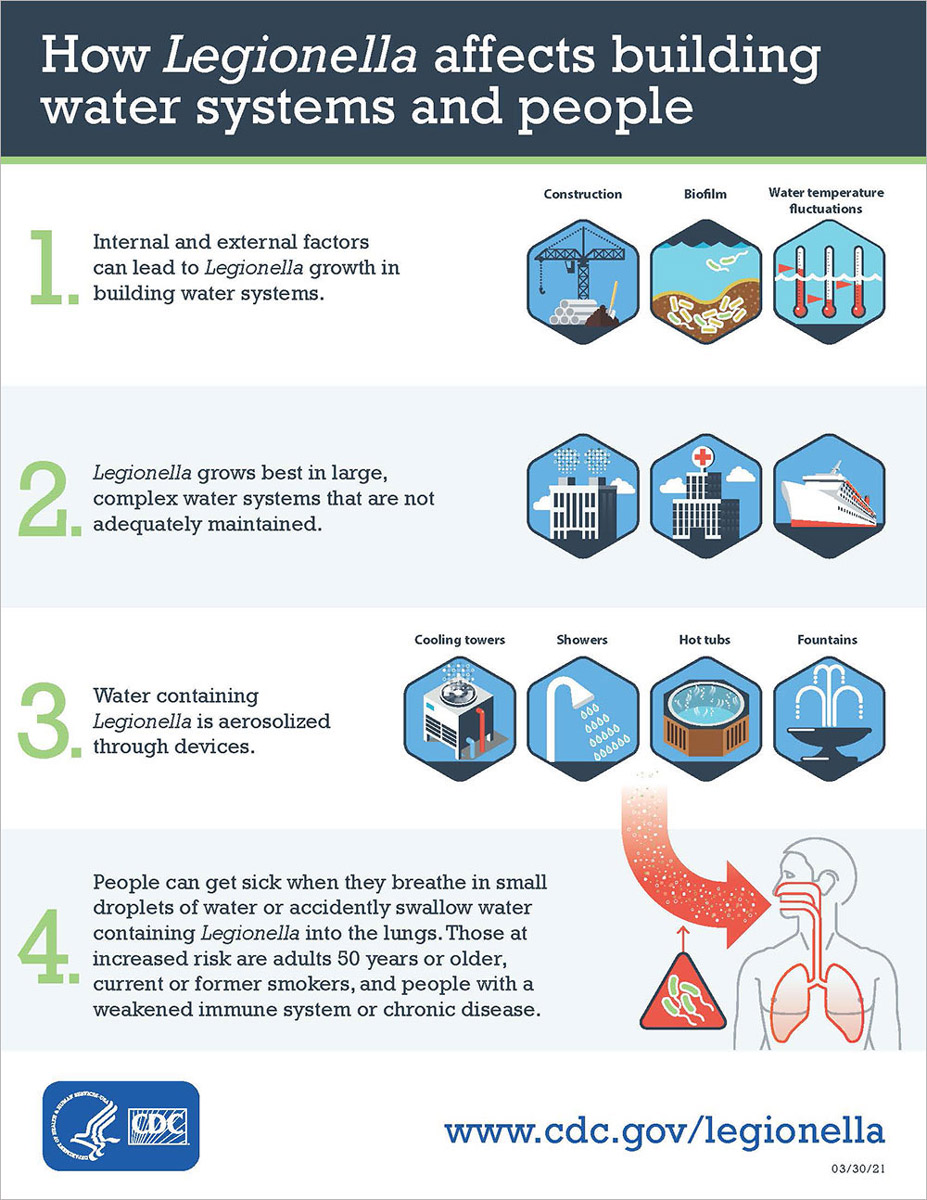Legionellosis is caused by exposure to the bacteria Legionella, and is a term used to describe multiple diseases, including Legionnaire’s Disease, Pontiac Fever or Extrapulmonary Legionellosis. The Legionella bacteria are found naturally in the environment, usually in water. The bacteria grow best in warm water, like the kind found in hot tubs, cooling towers, hot water tanks, large plumbing systems, and decorative fountains that are not properly maintained. They do not seem to grow in car or window air-conditioners.
Legionellosis can cause two diseases to occur, Legionnaires' disease and Pontiac Fever. People get Legionnaires' disease or Pontiac Fever when they breathe in a mist or vapor (small droplets of water in the air) containing the bacteria. The bacteria are not spread from one person to another person. A person diagnosed with Legionnaires' disease is not a threat to others who share office space or other areas with him or her.
FAQ
Source: NYSDOH Legionellosis FAQ web page; last reviewed July 2017.
Last reviewed by TCWH: August 2023
What is Legionnaires' disease (Legionellosis)?
Legionnaires' disease (Legionellosis) is a bacterial disease which may cause pneumonia. Between 200 and 800 cases are reported each year in New York State, including New York City. Most cases occur as single isolated events. Outbreaks are relatively rare.
Why is it called Legionnaires' disease and Legionellosis?
An outbreak of this disease in Philadelphia in 1976, largely among people attending a state convention of the American Legion, led to the name "Legionnaires' disease." Subsequently, the bacterium causing the illness was named Legionella pneumophila and the name of the illness was changed to Legionellosis.
Is this a new disease?
No. The bacterium was first identified in 1976, but earlier cases have been confirmed as far back as 1947.
How widespread is Legionnaires' disease?
It is estimated that about 25,000 people develop Legionnaires' disease in the United States each year. An additional unknown number are infected with the Legionella bacterium and have mild symptoms or no illness at all. Cases occur sporadically and in outbreaks. Outbreaks occur most often in the summer but cases occur all year round.
How severe is the illness?
Legionnaires' disease can be a mild respiratory illness or it can be severe enough to cause death. From 10 to 40 percent of healthy adults have antibodies showing previous exposure to the organism, but only a small percentage have a history of previous pneumonia.
Where are Legionella found?
Legionella exist naturally in water and moist soil. They have been found in creeks and ponds, hot and cold water taps, hot water tanks, water in air conditioning cooling towers and evaporative condensers, and soil at excavation sites.
How is Legionnaires' disease spread?
The disease appears to be spread through the air from a soil or water source. All studies to date have shown that person-to-person spread does not occur.
Who gets Legionnaires' disease?
Most healthy individuals do not become infected with Legionella bacteria after exposure. People at higher risk of getting sick are those 50 years of age or older, current or former smokers, those with a chronic lung disease (like COPD or emphysema), those with a weak immune system from diseases like cancer, diabetes, or kidney failure, and people who take drugs that suppress (weaken) the immune system (like after a transplant operation or chemotherapy).
What are the usual symptoms of Legionnaires' disease?
The early symptoms of Legionnaires' disease may be flu-like with muscle aches, headache, tiredness and dry cough followed by high fever, chills and occasionally diarrhea. Temperatures commonly reach 102-105 degrees Fahrenheit and chest X-rays often show pneumonia.
How soon do symptoms occur/appear?
The incubation period for Legionnaires' disease ranges from two to 14 days, but is usually five to six days.
What is the treatment for legionellosis?
Antibiotics such as erythromycin, levaquin or azithromycin appear to be effective in treating the disease.
Why is Legionnaires' disease so difficult to diagnose?
Legionnaires' disease often causes symptoms similar to those caused by other organisms, including influenza virus and other types of bacterial pneumonia. In addition, the specific laboratory tests needed to confirm the diagnosis are not always requested. The diagnosis depends on very specialized laboratory tests involving culture of the patient's sputum or detecting the organism in urine. Routine laboratory tests will not identify the Legionella bacteria.
When does the health department investigate a case of Legionnaires' disease?
Because sporadic cases are common and presently not preventable, they are often investigated only to confirm the diagnosis and rule out an outbreak. If an outbreak occurs, an investigation to look for a possible environmental source is conducted.
What is Pontiac Fever?
Pontiac fever is a milder illness. While symptoms of Pontiac fever could appear similar to those described for Legionnaires’ disease, there are distinguishing clinical features. Pontiac fever does not present as pneumonia. It is less severe than Legionnaires’ disease, rarely requiring hospitalization. Pontiac fever is self-limited, meaning it resolves without antibiotic treatment.


